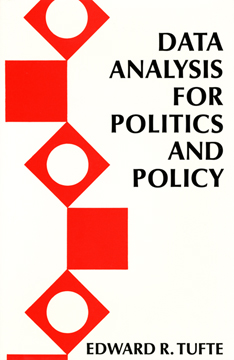|
Data Analysis For Politics And Policy
"Edward R. Tufte's book Data Analysis for Politics and Policy is,
quite simply, excellent. The aims of the author in the writing of this book is `. . . to
present fundamental material not found in statistics books, and in particular, to show
techniques of quantitative analysis in action on problems of politics and policy.' To
achieve this end, Tufte considers a narrow range of important topics in statistical
analysis, primarily dealing with problems of prediction (including a good discussion of
the concept of causation) and the relationships among variables through simple and
multiple regression.
The bulk of the book concerns the use and interpretation of
simple and multiple regression. Here, the discussion centers on issues that, as Tufte
claims, do not usually find a place in standard statistics texts. For example, in simple
regression, the book stresses the central role of residuals and residual analysis, and
describes many of the measures familiar to social scientists as functions of the residuals,
`. . . since reasonable measures of the quality of a line's fit to the data could hardly
be anything but a function of the magnitudes of the errors.' Tufte puts residual plots
to good use to gain understanding of a data set, and he shows how finding outliers gives
the analyst hints about the inadequacy of a statistical model. This attitude is clearly
passed along to the reader. The discussion of graphical techniques in general is quite
good and includes the reproduction of graphs of several scatter plots.
Other topics in simple regression are also considered. A brief but
compelling discussion of the `value of data as evidence,' with regard to the interpretation
of nonrandom samples, is presented. An important discussion of the usefulness of computing
slopes instead of correlation coefficients is given, complete with a good quote from John
Tukey. Several examples requiring transformations of one or both variables to the logarithmic
scale are given, along with an interpretation of transformed variables. The section on
transformations is difficult for many students, but it contains information that is not
usually available to the beginning nontechnical student.
For the last two years, I have used Data Analysis for Politics
and Policy as a supplemental text in a demanding statistics service course for first
year social science graduate students. The book has received almost uniform praise from
the students."
Sanford Weisberg, "Review of Data Analysis for Politics and Policy," Journal
of the American Statistical Association (September 1976), 768. 179 pages.
| $9 |
 |
|
|

|